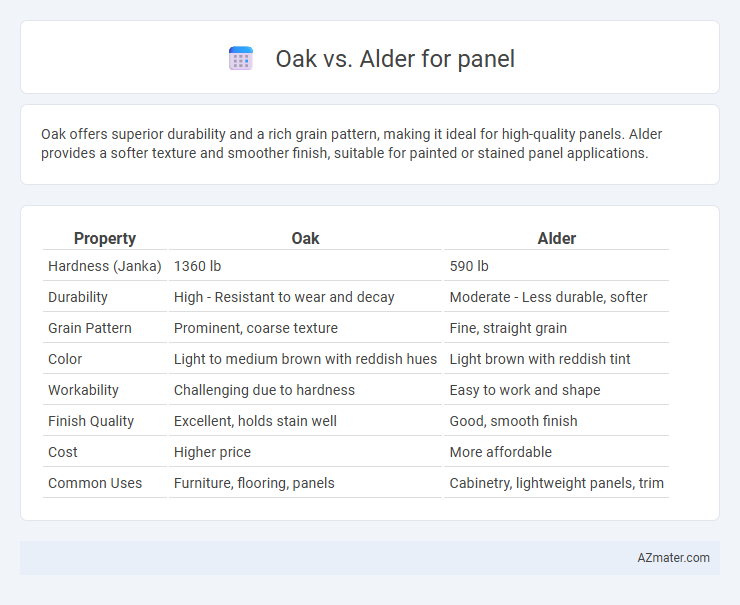Oak offers superior durability and a rich grain pattern, making it ideal for high-quality panels. Alder provides a softer texture and smoother finish, suitable for painted or stained panel applications.
Table of Comparison
| Property | Oak | Alder |
|---|---|---|
| Hardness (Janka) | 1360 lb | 590 lb |
| Durability | High - Resistant to wear and decay | Moderate - Less durable, softer |
| Grain Pattern | Prominent, coarse texture | Fine, straight grain |
| Color | Light to medium brown with reddish hues | Light brown with reddish tint |
| Workability | Challenging due to hardness | Easy to work and shape |
| Finish Quality | Excellent, holds stain well | Good, smooth finish |
| Cost | Higher price | More affordable |
| Common Uses | Furniture, flooring, panels | Cabinetry, lightweight panels, trim |
Introduction to Oak and Alder Woods
Oak wood, known for its durability and prominent grain patterns, is a favored choice in paneling due to its strength and resistance to wear. Alder wood, a softer hardwood with a fine, consistent texture, offers a smoother finish and takes stain evenly, making it ideal for versatile panel designs. Both woods provide distinct aesthetic and functional qualities, with oak delivering robustness and alder ensuring ease of workability.
Key Differences Between Oak and Alder
Oak panels offer exceptional durability and a pronounced grain pattern, making them ideal for high-traffic areas and classic designs, while alder panels provide a smoother, more uniform texture with softer tones suited for contemporary and rustic interiors. Oak tends to be harder and more resistant to dents and scratches, whereas alder is easier to work with and takes stains well, allowing for versatile finishing options. Oak's natural resistance to moisture makes it preferable for moisture-prone environments, in contrast to alder's susceptibility to water damage unless properly sealed.
Wood Grain and Appearance Comparison
Oak wood features a prominent, coarse grain with distinct rays and flecks that create a textured, visually striking appearance ideal for traditional and rustic paneling. Alder wood exhibits a finer, more uniform grain pattern with subtle growth rings, offering a smoother, warmer look suitable for contemporary and minimalist designs. The natural color contrast is also notable, with oak ranging from light tan to medium brown and alder presenting a consistent reddish-brown hue, enhancing the decorative appeal of panels.
Strength and Durability: Oak vs. Alder
Oak is renowned for its exceptional strength and durability, making it ideal for long-lasting panels that withstand heavy use and wear. Alder, while softer and less dense than oak, offers good durability but is more prone to dents and scratches over time. Oak's higher Janka hardness rating, typically around 1360, significantly exceeds alder's approximate rating of 590, highlighting oak's superior resistance to impact and structural wear.
Workability and Machining Properties
Oak offers excellent workability with a moderate to high density that allows for smooth machining and detailed cuts, making it ideal for durable and aesthetically pleasing panels. Alder, being softer and less dense, is easier to machine and shape with less tool wear, providing a more cost-effective solution for panels needing fine surface finishes. Both woods respond well to sanding and finishing, but alder's consistent grain pattern reduces the risk of splintering during work compared to oak.
Cost and Availability of Oak and Alder
Oak panels typically cost more than alder due to oak's greater density, durability, and slower growth rate, which limits supply. Alder is more affordable and widely available because it grows faster and is abundant in many regions, making it a cost-effective choice for paneling. The price difference often reflects oak's premium quality and longer lifespan compared to alder's versatility and budget-friendly nature.
Finishing and Staining Qualities
Oak offers excellent finishing qualities due to its open grain, which absorbs stains evenly, resulting in a rich, uniform color ideal for high-end paneling. Alder, with its fine, consistent grain, takes stains and finishes smoothly but tends to produce a softer, more muted appearance compared to oak. Both woods respond well to various finishes, but oak's natural hardness and pronounced grain make it preferable for durable, visually striking stained panels.
Environmental Impact and Sustainability
Oak panels offer exceptional durability and longevity, reducing the need for frequent replacement and thus lowering environmental impact over time. Alder wood, sourced from faster-growing trees, supports sustainable forestry practices by minimizing deforestation and promoting carbon sequestration. Choosing alder panels enhances eco-friendliness through renewable resource use, while oak's strength contributes to long-term sustainability by decreasing material waste.
Best Applications for Oak and Alder Panels
Oak panels excel in applications requiring durability and aesthetic appeal, such as high-end furniture, cabinetry, and flooring, due to their dense grain and resistance to wear. Alder panels are best suited for interior decorative elements, including moldings, wall paneling, and painted finishes, thanks to their softer texture and smooth surface that accepts stain and paint well. Both woods offer versatility, but oak is preferred for structural uses, while alder is favored for cost-effective, finely finished interior projects.
Which Wood Should You Choose for Panels?
Oak offers superior durability, a rich grain pattern, and natural resistance to wear, making it an excellent choice for high-traffic panels. Alder wood is softer, easier to work with, and has a smooth, consistent texture ideal for painted or decorative panels. Choose oak for strength and longevity or alder for budget-friendly, versatile paneling options.

Infographic: Oak vs Alder for Panel
 azmater.com
azmater.com